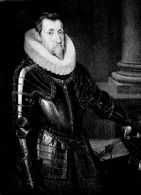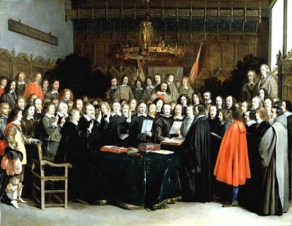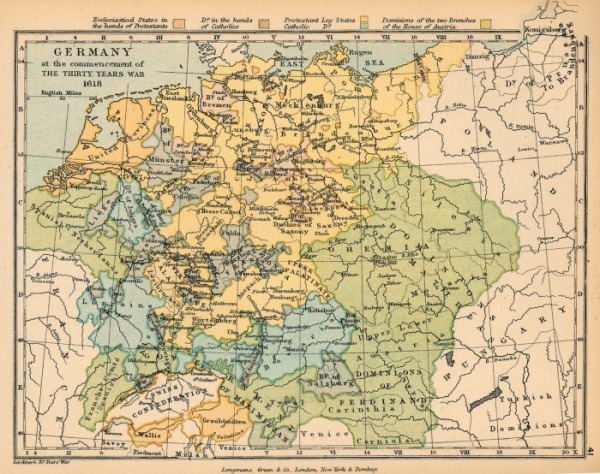THIRTY YEARS' WAR
Map of Europe; where most of the fighting occurred. Bohemia is where the war was ignited by Ferdinand II (green, left)
bibliography: http://www.lib.utexas.edu/maps/historical/colbeck/germany_30_years_war_1618.jpg
a RELIGIOUS battle
The Thirty Years’ War consisted of the religious side of power in Europe, and most importantly, France. Lutheran and Catholic forces were being oppressed by the spreading of Calvinism that was spreading like wildfire in Germany. Thus, Lutherans banded together to create Protestant Union the in 1608. Catholics did the same in creating the Catholic League in 1609. Tensions grew, and it turned out to be Ferdinand II, head of the Hapsburg family, that ignited the start of the Thirty Years’ War.
Ferdinand II ruled the Czech kingdom in Bohemia in 1618, and was not trusted as a foreign ruler (he himself was a Catholic and not of the Protestant view). Thus, the Protestants revolted when Ferdinand closed some Protestant churches. In order to settle the revolt, he sent an army to quiet down the rebellion, and in response, German Protestant princes stepped up and defended the Bohemians – this started the war.
who against who? ...against who?

Though it seemed as if the war was between Catholics and Protestants of Europe, it is more accurate to say that the war involved Catholics, Protestants and also the Hapsburg. The Catholics were against the Hapsburg in fear of the fact that they might come to gain more control and have more power than that of the French king.
Ferdinand II, the head of the Hapsburg family.
bibliography: http://www.uni-regensburg.de/Fakultaeten/phil_Fak_III/Geschichte/ferdinand2.jpg
Hapsburg Prime, Hapsburg Fall
The Hapsburgs of Austria and Spain gained momentum in the first 12 years of the war as they successfully silenced the Czech uprising, defeated the German Protestant princes that challenged the Bohemian authority, and also put down the power of the troops that the Protestant princes had hired to fight. However, the war shifted and the tables turned in 1630 with the help of a Swedish Protestant named Gustavus Adolphus.
FRANCE'S PART IN THE WAR

The French were heavily involved with the Thirty Years’ War later on. Under the rule of Cardinal Richelieu, The French actually allied with Protestant forces, particularly Sweden and some German Protestant leaders, in order to bring down the Hapsburg forces. They were successful in doing so.
France declared war on Spain, where most Hapsburg forces were based, in May of 1635, and slowly as an alliance, the Catholic and Protestant forces pushed the Hapsburg out of their position in the German states. Spain failed to capture French territory as they were blocked out, and the Hapsburgs no longer remained the favorites of the war. Peace talks were finally taking place in 1645
The Peace of Westphalia was sign at Münster, Germany on October 24, 1648.
bibliography: http://www.ibd2005.com/images/conventionof1648.jpg
after the French defeated the Austro-Bavarian (Hapsburg) army was defeated in Germany, but a real truce did not take place until 1648 through the Truce of Ulm, and eventually, the Peace of Westphalia.

